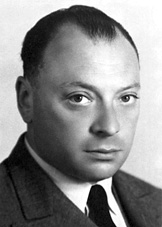Wolfgang Pauli
Claimed and written by Meghana Holegadde for PHYS 2211
Wolfgang Pauli was a physicist most commonly known for his Exclusion Principle and for being the proposition of the existence of the neutrino. He was awarded the Nobel Prize in Physics in 1945 for his work, which allowed a deeper understanding of the atom in the physics community.

Early Life and Education
Born April 25, 1900, Wolfgang Pauli was born and raised in Vienna. After completing his early education in Vienna, he studied under Arnold Sommerfield at the University of Munich. He earned his doctorate in 1921 and was an assistant to Max Born, Nobel Prize Winner in 1954 for Physics, at the University of Göttingen. In 1922, Pauli served as the assistant to Niels Bohr, another prominent physicist at the time, in Copenhagen. After serving as a lecturer at the University of Hamburg, Pauli was appointed as Professor of Theoretical Physics at the Federal Institute of Technology in Zurich. He soon progressed to the position of visiting professor at Princeton, University of Michigan, and Purdue University. After the end of World War II, Pauli returned to Zurich to continue his work at the university.
Research and discoveries
Described as one of the leaders of twentieth century physicists, even in his early twenties, Pauli's understanding of topics such as the theory of relativity, led him to early fame. The Pauli Exclusion Principle is his most recognized work, along other discoveries, such as being the first to recognize the existence of the neutrino.
Pauli Exclusion Principle
According to the Pauli Exclusion Principle, no two electrons in an atom can have the same quantum numbers. There are four electronic quantum numbers (n,l,m(l), and m(s)). The spin must always be different. The spin is formed by fermions and bosons. Fermions are particles of half-integer spin. Bosons are particles with integer spin. This means that if the fermions are identical, the bosons must be different, and vice versa.
Recognition of the neutrino
Neutrinos are pretty much undetectable at first glance. They weigh nothing and interact with nothing. However, with the discovery of beta decady, there way a discovery that the electron carried off less energy than originally anticipated. At first, there was no explanation. Then Wolfgang Pauli wrote a letter, which would quickly become famous, proposing that a light neutral particle with a spin of 1/2 was emitted along with the electron during beta decay. Pauli originally called it a neutron, but was renamed after the current day neutron was discovered.
Detecting this particle was nearly impossible and Pauli even began to think that his prediction may have just been false speculation. After advances in nuclear fission in the 1930's and 40's, this particle was finally detected in a realistic amount.
Relevance in Modern day Physics
The Pauli Exclusion Principle and the neutrino play a huge role in physics today. The Exclusion Principle explains a wide variety of unique physical phenomena. The neutrino clears up much of the confusion regarding beta decay. Without Pauli's discoveries, much of the information on the atomic level may have still been under investigation.
See also
Further reading
General Principles of Quantum Mechanics by Wolfgang Pauli, P. Achuthan (Translator), K. Venkatesan (Translator)
Theory of Relativity by Wolfgang Pauli, A. Sommerfeld (Photographer)
External links
For a more detailed explanation regarding fermions and bosons, the link below has a great visual! http://www.particleadventure.org/pauli.html
References
http://www.nobelprize.org/nobel_prizes/physics/laureates/1954/index.html http://www.nobelprize.org/nobel_prizes/physics/laureates/1945/pauli-bio.html http://hyperphysics.phy-astr.gsu.edu/hbase/pauli.html http://chemwiki.ucdavis.edu/Inorganic_Chemistry/Electronic_Structure_of_Atoms_and_Molecules/Electronic_Configurations/Pauli_Exclusion_Principle https://www.goodreads.com/book/show/445144.Theory_of_Relativity http://t2k-experiment.org/neutrinos/a-brief-history/